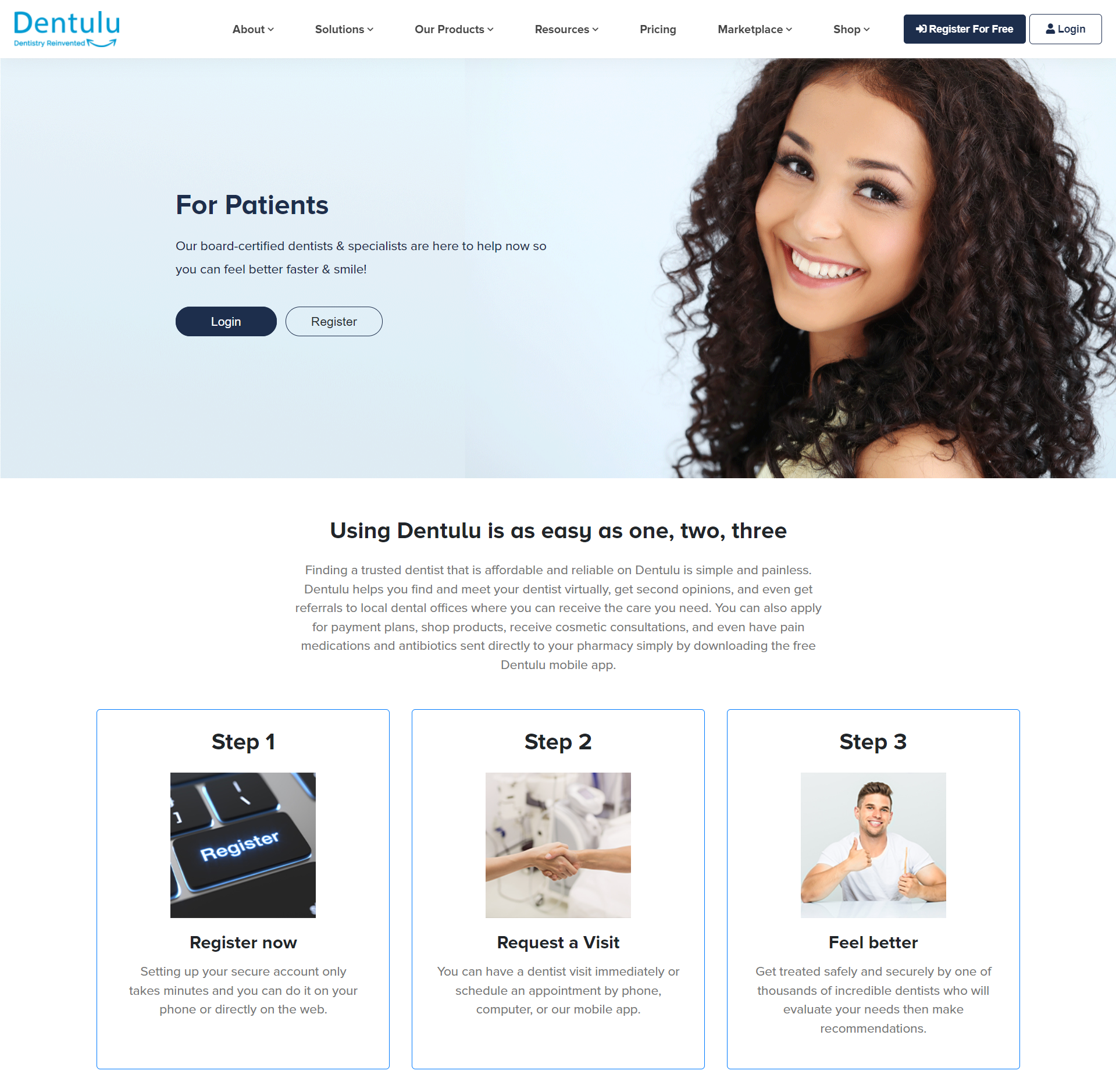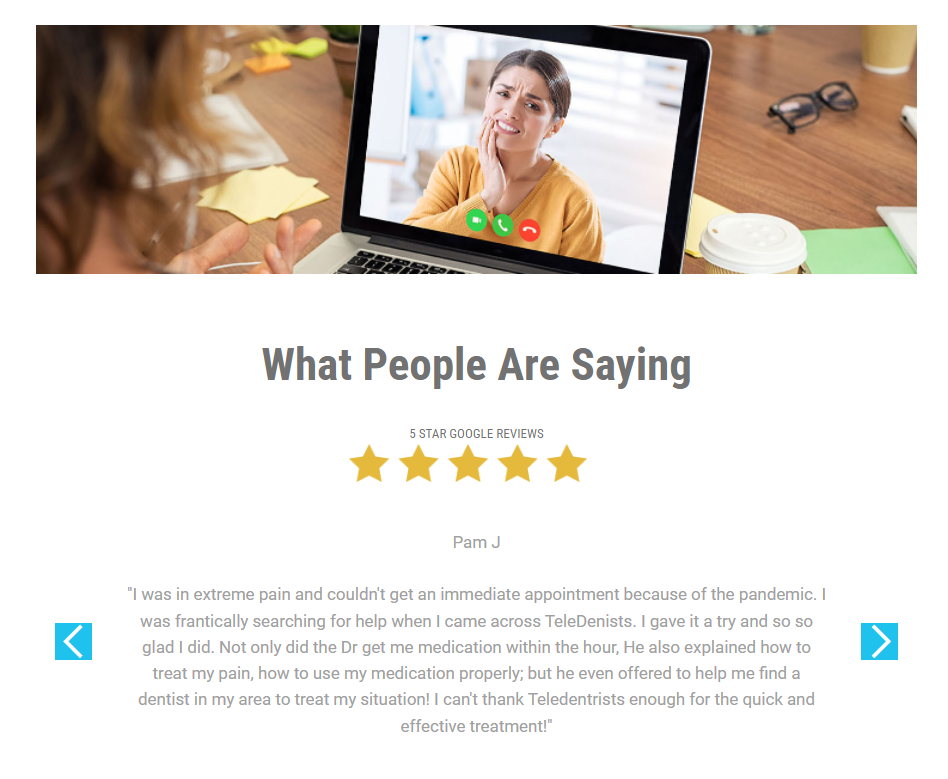Without question, the global pandemic brought teledentistry into the foreground with speed. Data from Delta Dental, a group out of California, shows their providers saw 30 times as many synchronous and 10 times asynchronous teledentistry appointments in 2020.
What’s even more interesting in that particular data is that teledentistry adoption remains above pre-COVID levels (though it has come back down to earth). Separate research published in Oral Health supports the notion that teledentistry has a post-pandemic future:
- 50% of dentists implemented a teledentistry program during the pandemic
- 75% of dentists think their teledentistry program has been successful
- 46% percent of dentists plan to continue their teledentistry program post-pandemic
Anecdotally, we see the same trend among the practices and dental support organizations (DSOs) that we work with.
Synchronous vs. Asynchronous Teledentistry
Picture a live Zoom video call, but with your dentist. Video and audio are enabled, as are your microphones, and the remote visit is happening in real-time. That’s the basic definition of synchronous teledentistry.
With asynchronous teledentistry, patients submit information about their issue—a photo, scan, lab, and so on—to their provider. The provider can then review the data on their own time and either:
- Record and submit a video response about treatment options, estimated cost, etc.
- If necessary, forward the information to a specialist who can recommend the proper treatment
Here’s a great overview of asynchronous teledentistry from Dentulu:
Why It’s Time for DSOs to Double Down on Teledentistry Investments
Before the pandemic, healthcare consumers were already demanding more convenience on their dental journeys. The pandemic and its itinerant rise in teledentistry only dialed up this demand. Assuming teledentistry sticks around (as many believe it will), DSOs have a chance to turn their teledentistry programs into differentiators.
Benefits to Patients
One of the original and enduring benefits of teledentistry is its ability to help patients overcome access issues. This includes patients with disabilities or those who live in remote areas. As of 2021, more than 63 percent of so-called Dental Health Professional Shortage Areas were located in rural areas. Not surprisingly, the rate of tooth loss and other oral health issues is much higher in these areas.
Convenience is another benefit to patients. Most patients prefer to connect with their providers on their own time rather than interrupting their day with a two-hour trip to the dentist’s office. Telehealth often saves patients the hassle of in-office visits for consultations that can be conducted remotely. These include initial examinations and triage, or even follow-ups.
In our expert roundtable, Leslie Gibbs, Chief Marketing Officer, shared the real-world impact teledentistry is having for her company, Modern Vascular:
“Our consumer is more nervous. We tend to target seniors over sixty with concerns about leaving the house. They need assurance. Peripheral artery disease is a life-threatening disease. So we’re having those dialogs with patients understanding from a remote consultation what symptoms they’re having and encouraging them to come in if the symptoms are aggressive enough. We did a lot of triage early on, so we didn’t have to postpone lifesaving procedures.”
Benefits to Dentists
Did you know that there are more than 1600 patients per dentist in the United States? No wonder appointments are sometimes difficult to come by. Given that ratio, busy dentists need every efficiency gain they can get.
Asynchronous teledentistry is particularly useful in this regard. In a traditional setting, patients schedule an appointment and come into the office before the dentist can assess their condition and make a referral. With asynchronous teledentistry, the patient can submit all of the data beforehand. The dentist then reviews the data (on their own time) and makes the necessary recommendations or referrals.
Yet even synchronous teledentistry can help ease high patient load. Many initial consultations, for example, can be handled over a video call, which takes up far less time than a traditional in-person visit.
5 Teledentistry Marketing Best Practices
Of course, teledentistry isn’t a “build it and they will come” scenario. On the contrary, most dental consumers either don’t know that you offer remote visits, don’t trust remote visits, or couldn’t be bothered enough to care. By implementing, evangelizing, and iterating the following best practices, you can build a more successful teledentistry offering:
1. Use Digital Channels to Build Visibility for Your Teledentistry Program
You can start by asking your web team to build out a dedicated teledentistry page on your website and add it to your main navigation. Use this page to educate and inform new and existing patients about all aspects of your teledentistry offering, including:
- How remote visits work and what to expect
- How to access your remote visit
- What you need in terms of a computer, mobile device, etc.
- Troubleshooting guide and support information
- Information about which visits can be conducted remotely
- Teledentistry frequently asked questions (FAQs)
Ideally, this page is search-optimized so that people searching Google for teledentistry options can find it as well. Once you’ve built a dedicated teledentistry webpage, you can use it as a destination link across a variety of channels, including:
- Website banners
- Social media channels
- Email campaigns and sequences
- Paid advertising campaigns
- Blog posts, articles, and publications
- Phone message systems and call scripts
- Customer service chatbots
2. Win Patients Over with a Compelling Message
The other day, I received a direct mail flier from a local hospital network about telehealth. The headline of this flier? “$0 for most telehealth visits.” On the back, the flier succinctly describes the benefits of telehealth for patients in four bullet points (convenient 24/7 care, privacy, etc.).

While direct mail is undoubtedly an option for increasing telehealth adoption, the point is that you need a message and offer that people care about. One fundamental way to make people care is to overcome their objections to teledentistry, of which there are a few common ones:
- It’s not as good or effective as in-person care
- It’s an extra, unnecessary expense that isn’t covered by insurance
- It requires technical expertise and too much hassle getting everything set up
Finally, be honest about the pros and cons. Is teledentistry going to replace in-person visits? No! Is it the perfect solution for every scenario? Not by a longshot. The point is to educate patients about where a remote visit can make a lot of sense and where they might be better off coming into the office. There’s nothing wrong with acknowledging the good and the bad.
In fact, most patients will appreciate you for it.
3. Make the User Experience as Good as it Can Be
Technical obstacles and poorly designed teledentistry experiences can be a major barrier to adoption. From start to finish—for both synchronous and asynchronous appointments—you need to make it easy for your patients to participate in their teledentistry appointments.
After a patient books an appointment, remind them via email and text (if possible) of their upcoming appointment. In those automated follow-up sequences, include the following information to help prepare patients:
- Appointment time and date (including “add to calendar” option)
- Telehealth technology requirements
- Step-by-step instructions on how to access their virtual appointment
- Telehealth consent forms
- Contact information if they have any questions
- Instructions on what to do should there be problems with the video session
- Links to FAQ and troubleshooting
Lastly, choose a good teledentistry solution, such as Dentulu or Teledentix. Your solution should be mobile optimized, secure, and simple for patients to access. Pay close attention to the waiting room experience, where patients will go to right before the appointment starts. This is yet another opportunity for patients to test their audio/video connection in preparation for the call.

4. Educate Patients on Where Teledentistry Fits Into the Bigger Picture
Teledentistry isn’t meant to supplant in-person care but to supplement it.
One of the easiest ways to illustrate this to patients is to explain which appointment types are eligible for your teledentistry program. For example, we’ve seen dental practices publish “roadmaps” for each step in major dental surgery, indicating where teledentistry is used (initial consultation, for example, or post-op checkup).
Another way to educate both new and existing patients about teledentistry is to write about it. Demonstrate your authority by covering any and all teledentistry topics that might bring value to patients. This content can be disseminated through email, social media, and other channels.
We’ve also seen dental practices build out video overviews, podcast episodes, and even Facebook Live events to educate patients about teledentistry. Smile Doctors published excellent educational content about teledentistry.
5. Showcase Reviews and Testimonials from Teledentistry Participants
Despite increasing adoption, teledentistry is still off-putting for a lot of people. Or at least unfamiliar. One of the most effective ways to show patients how teledentistry can help them is in the words of other patients. This is where testimonials, reviews, and other forms of social proof come in extremely handy.
Video testimonials might be the most engaging and versatile asset in this regard. You can record a short video interview with a patient, inviting them to share their experiences with teledentistry (how they used and benefited from it).
Reviews and ratings left on Google My Business, Yelp, 1-800 Dentist, and other sites can be showcased on your website as well. You can even share particularly strong reviews on other channels.

Automated customer satisfaction surveys can provide useful data points that lend credibility to your teledentistry program. Composite customer satisfaction scores, or average ratings, are two common examples.
“Telehealth adoption for the healthcare consumer over the last six to eight years is almost like a hockey stick. Once you get into those experiences and use them, you’re more apt to use them more with more confidence and trust. It’s for certain healthcare conditions where it’s easiest to build trust. Telehealth is one component of a broader part of what patients value about their healthcare journeys.”
–Jennifer Schultz, Senior Vice President of Marketing & Communications, OU Medicine
Finally, Know that You Have Options
A teledentistry program can be time-consuming and expensive to deploy. Indeed, standing up a teledentistry offering is challenging, especially for small dental offices. Still, there are other ways to make teledentistry part of your offering.
Many dentists consider joining a dental service organization (DSO) for tech and marketing support related to teledentistry. Others work with specialized teledentistry software providers. Whichever route you go, do your due diligence and always keep the patient experience in mind.
Should you already have a teledentistry program in place, adherence to the five best practices described above ought to serve your patients well.

